Employee Engagement: Literature Review and HR Practices
VerifiedAdded on 2022/12/29
|9
|2235
|100
Report
AI Summary
This management report focuses on employee engagement, specifically within the context of Marks and Spencer (M&S). The report begins with an abstract defining employee engagement and its significance. It then delves into a literature review, exploring various theories and the benefits of employee engagement, such as increased efficiency, reduced turnover, and improved customer satisfaction. The report highlights the importance of proactive personalities and transformational leadership in fostering engagement. It also examines the impact of emotional labor. Furthermore, the report analyzes HR practices related to employee engagement, including feedback surveys, training, employee motivation and well-being, understanding employees' contributions, creating a healthy competitive environment, and attracting the right talent. The report concludes with recommendations for M&S, such as conducting employee engagement surveys and communicating the importance of each employee’s role in achieving organizational goals. The report references various academic sources to support its findings and recommendations. This report is available on Desklib, a platform offering AI-based study tools for students.
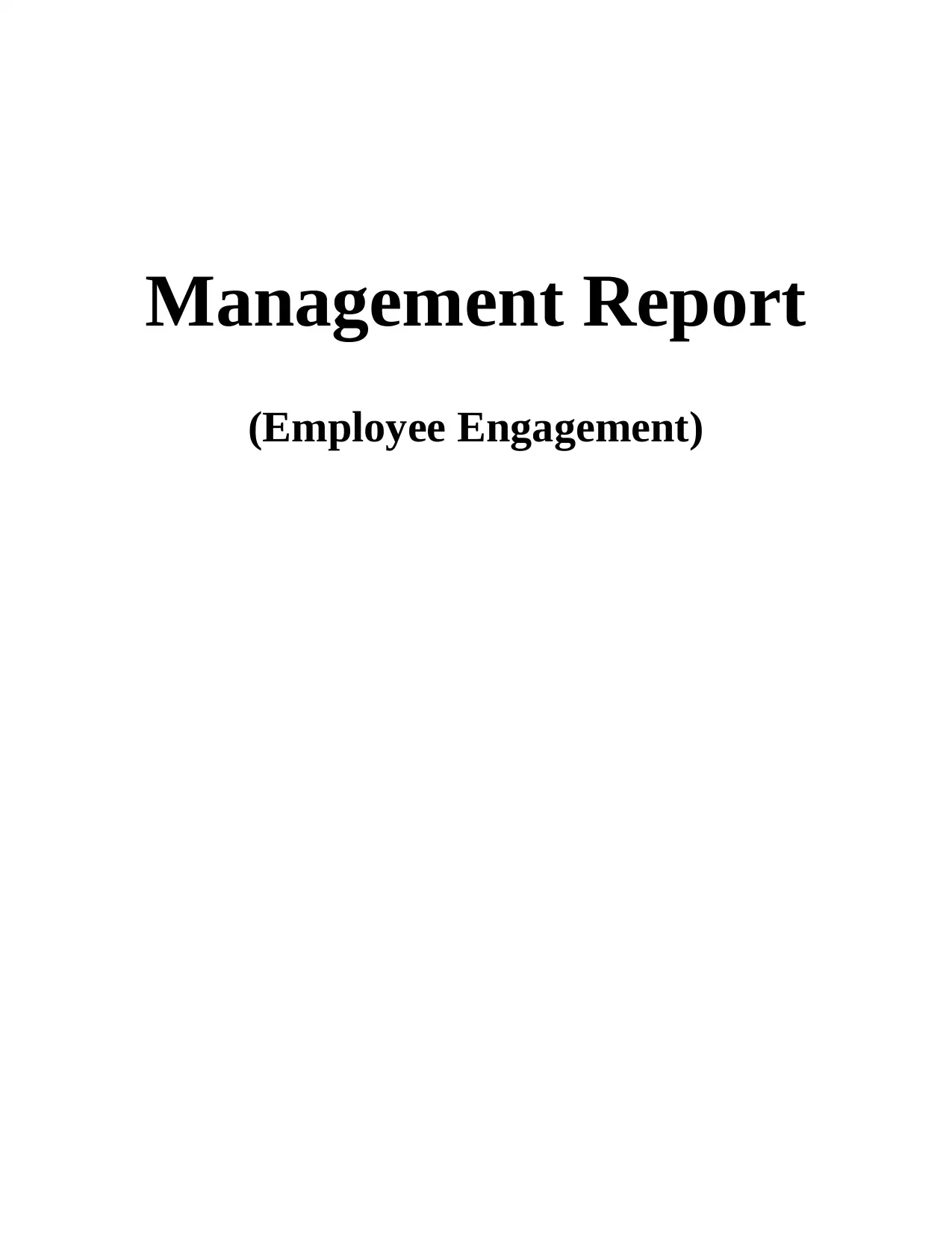
Management Report
(Employee Engagement)
(Employee Engagement)
Paraphrase This Document
Need a fresh take? Get an instant paraphrase of this document with our AI Paraphraser
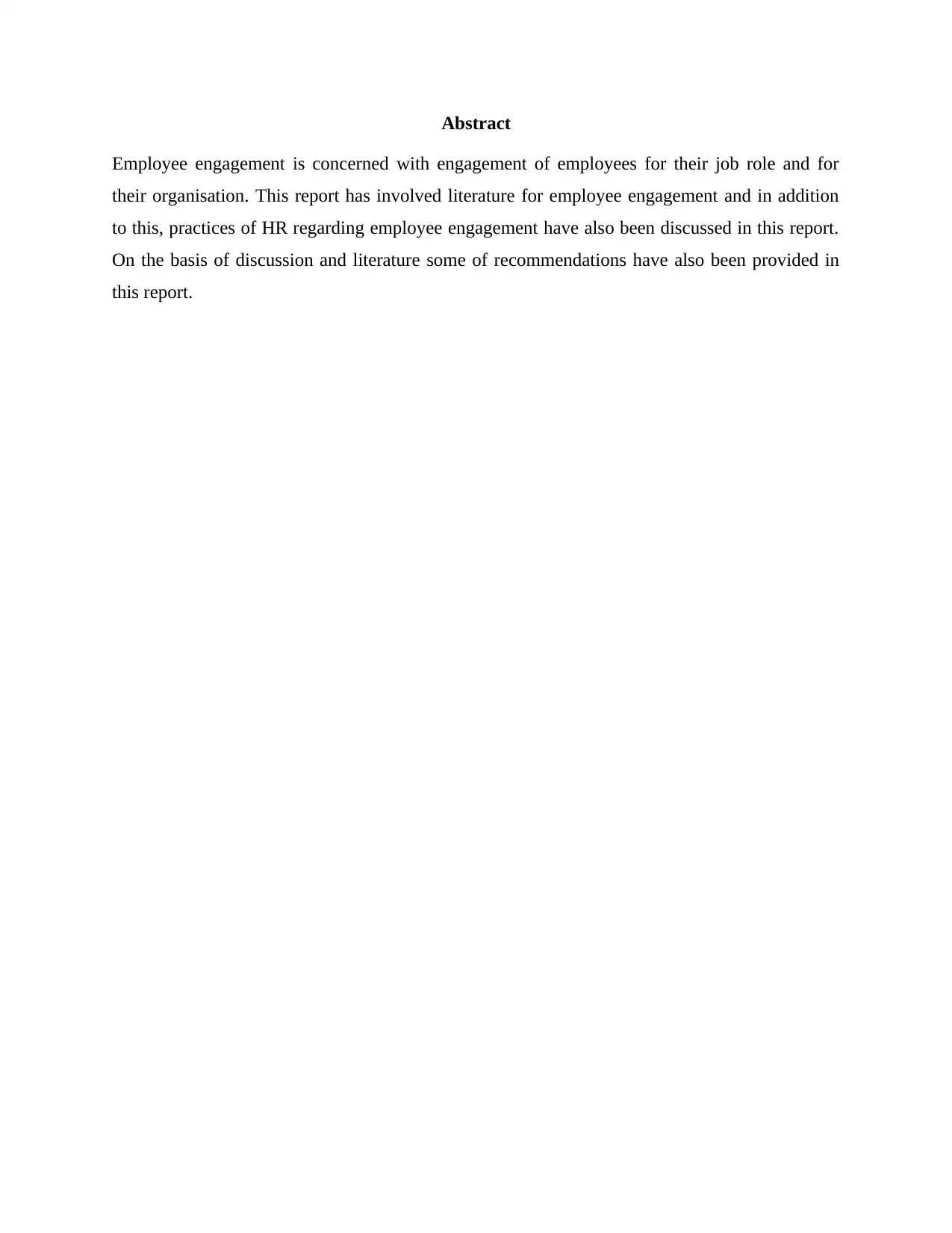
Abstract
Employee engagement is concerned with engagement of employees for their job role and for
their organisation. This report has involved literature for employee engagement and in addition
to this, practices of HR regarding employee engagement have also been discussed in this report.
On the basis of discussion and literature some of recommendations have also been provided in
this report.
Employee engagement is concerned with engagement of employees for their job role and for
their organisation. This report has involved literature for employee engagement and in addition
to this, practices of HR regarding employee engagement have also been discussed in this report.
On the basis of discussion and literature some of recommendations have also been provided in
this report.
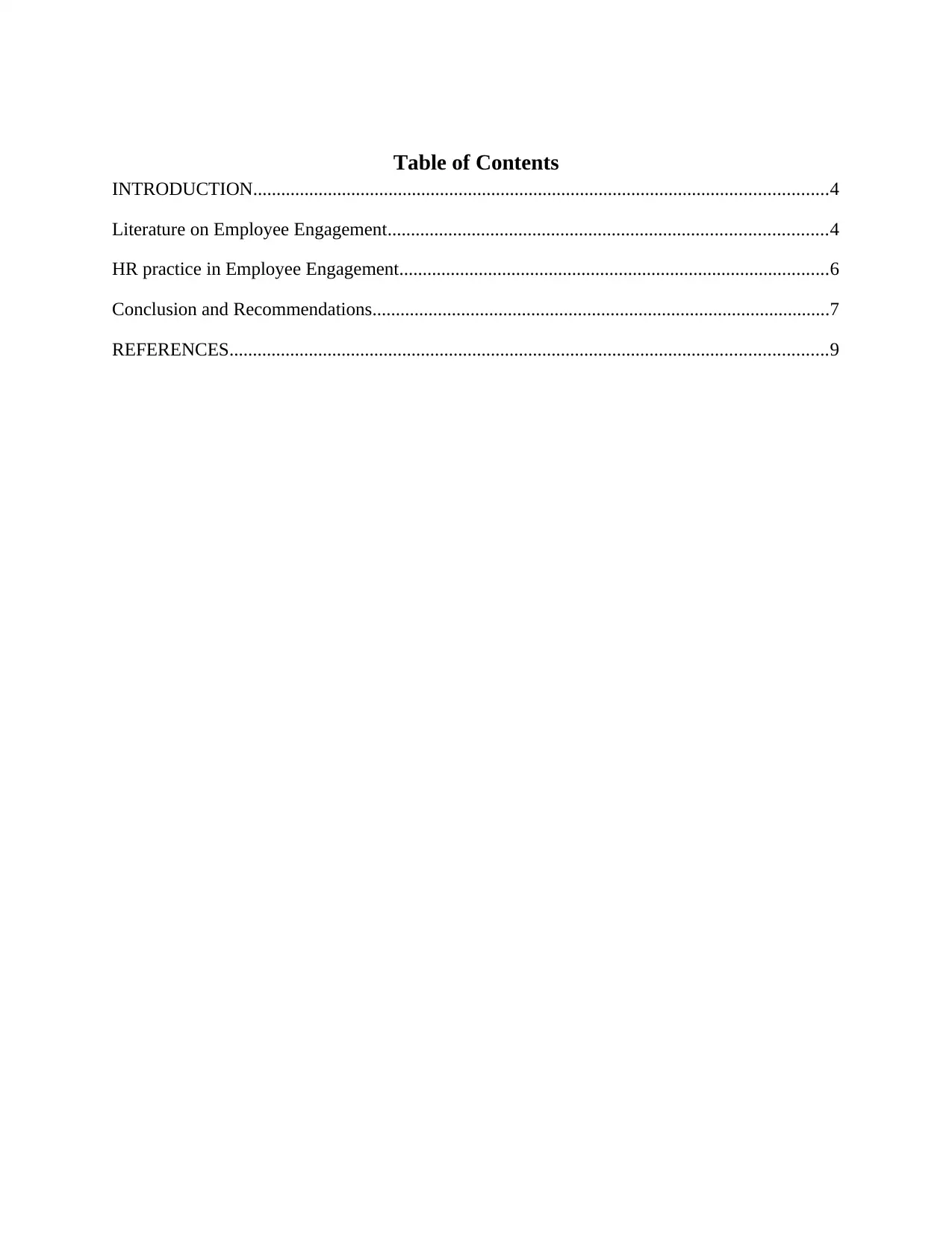
Table of Contents
INTRODUCTION...........................................................................................................................4
Literature on Employee Engagement..............................................................................................4
HR practice in Employee Engagement............................................................................................6
Conclusion and Recommendations..................................................................................................7
REFERENCES................................................................................................................................9
INTRODUCTION...........................................................................................................................4
Literature on Employee Engagement..............................................................................................4
HR practice in Employee Engagement............................................................................................6
Conclusion and Recommendations..................................................................................................7
REFERENCES................................................................................................................................9
⊘ This is a preview!⊘
Do you want full access?
Subscribe today to unlock all pages.

Trusted by 1+ million students worldwide
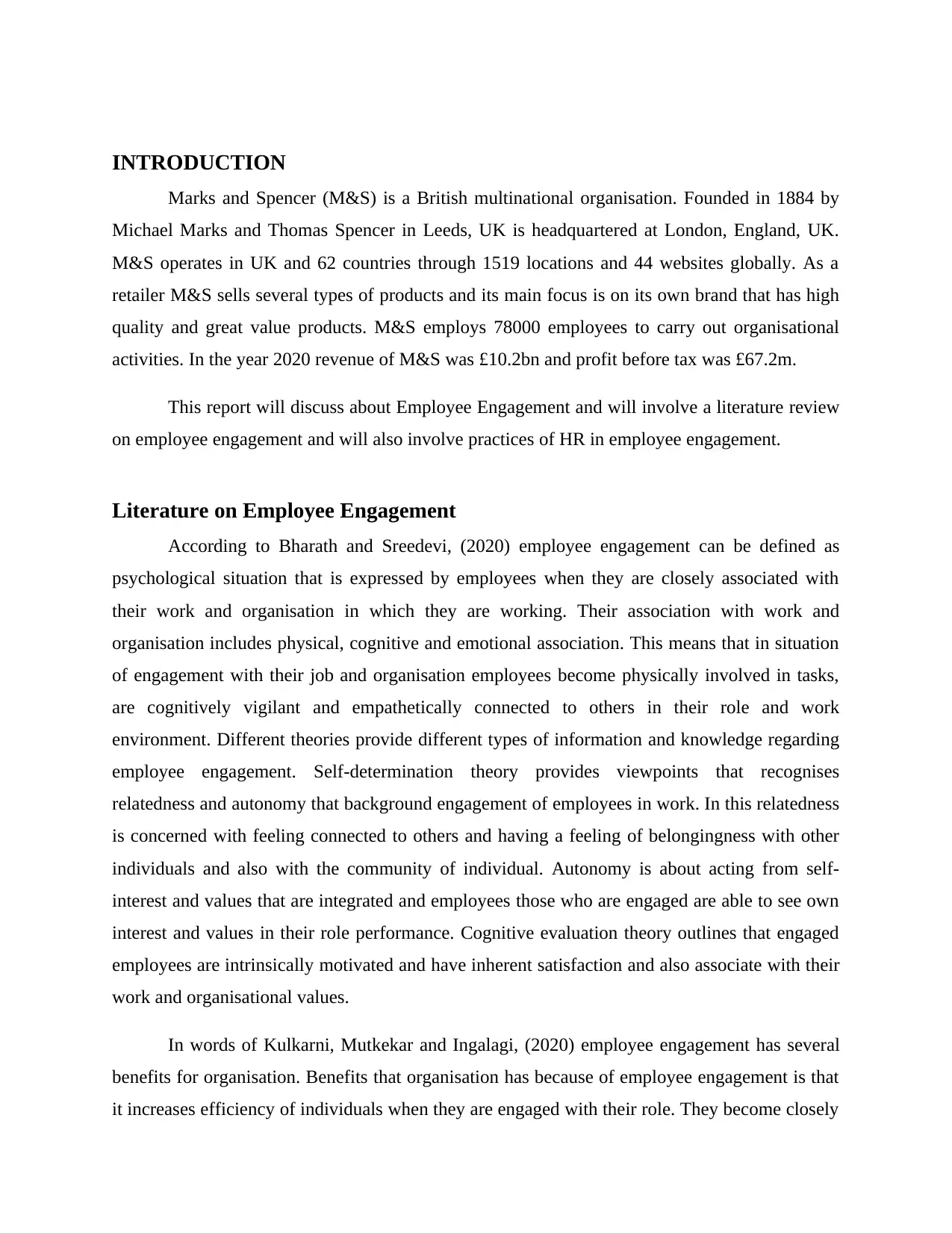
INTRODUCTION
Marks and Spencer (M&S) is a British multinational organisation. Founded in 1884 by
Michael Marks and Thomas Spencer in Leeds, UK is headquartered at London, England, UK.
M&S operates in UK and 62 countries through 1519 locations and 44 websites globally. As a
retailer M&S sells several types of products and its main focus is on its own brand that has high
quality and great value products. M&S employs 78000 employees to carry out organisational
activities. In the year 2020 revenue of M&S was £10.2bn and profit before tax was £67.2m.
This report will discuss about Employee Engagement and will involve a literature review
on employee engagement and will also involve practices of HR in employee engagement.
Literature on Employee Engagement
According to Bharath and Sreedevi, (2020) employee engagement can be defined as
psychological situation that is expressed by employees when they are closely associated with
their work and organisation in which they are working. Their association with work and
organisation includes physical, cognitive and emotional association. This means that in situation
of engagement with their job and organisation employees become physically involved in tasks,
are cognitively vigilant and empathetically connected to others in their role and work
environment. Different theories provide different types of information and knowledge regarding
employee engagement. Self-determination theory provides viewpoints that recognises
relatedness and autonomy that background engagement of employees in work. In this relatedness
is concerned with feeling connected to others and having a feeling of belongingness with other
individuals and also with the community of individual. Autonomy is about acting from self-
interest and values that are integrated and employees those who are engaged are able to see own
interest and values in their role performance. Cognitive evaluation theory outlines that engaged
employees are intrinsically motivated and have inherent satisfaction and also associate with their
work and organisational values.
In words of Kulkarni, Mutkekar and Ingalagi, (2020) employee engagement has several
benefits for organisation. Benefits that organisation has because of employee engagement is that
it increases efficiency of individuals when they are engaged with their role. They become closely
Marks and Spencer (M&S) is a British multinational organisation. Founded in 1884 by
Michael Marks and Thomas Spencer in Leeds, UK is headquartered at London, England, UK.
M&S operates in UK and 62 countries through 1519 locations and 44 websites globally. As a
retailer M&S sells several types of products and its main focus is on its own brand that has high
quality and great value products. M&S employs 78000 employees to carry out organisational
activities. In the year 2020 revenue of M&S was £10.2bn and profit before tax was £67.2m.
This report will discuss about Employee Engagement and will involve a literature review
on employee engagement and will also involve practices of HR in employee engagement.
Literature on Employee Engagement
According to Bharath and Sreedevi, (2020) employee engagement can be defined as
psychological situation that is expressed by employees when they are closely associated with
their work and organisation in which they are working. Their association with work and
organisation includes physical, cognitive and emotional association. This means that in situation
of engagement with their job and organisation employees become physically involved in tasks,
are cognitively vigilant and empathetically connected to others in their role and work
environment. Different theories provide different types of information and knowledge regarding
employee engagement. Self-determination theory provides viewpoints that recognises
relatedness and autonomy that background engagement of employees in work. In this relatedness
is concerned with feeling connected to others and having a feeling of belongingness with other
individuals and also with the community of individual. Autonomy is about acting from self-
interest and values that are integrated and employees those who are engaged are able to see own
interest and values in their role performance. Cognitive evaluation theory outlines that engaged
employees are intrinsically motivated and have inherent satisfaction and also associate with their
work and organisational values.
In words of Kulkarni, Mutkekar and Ingalagi, (2020) employee engagement has several
benefits for organisation. Benefits that organisation has because of employee engagement is that
it increases efficiency of individuals when they are engaged with their role. They become closely
Paraphrase This Document
Need a fresh take? Get an instant paraphrase of this document with our AI Paraphraser
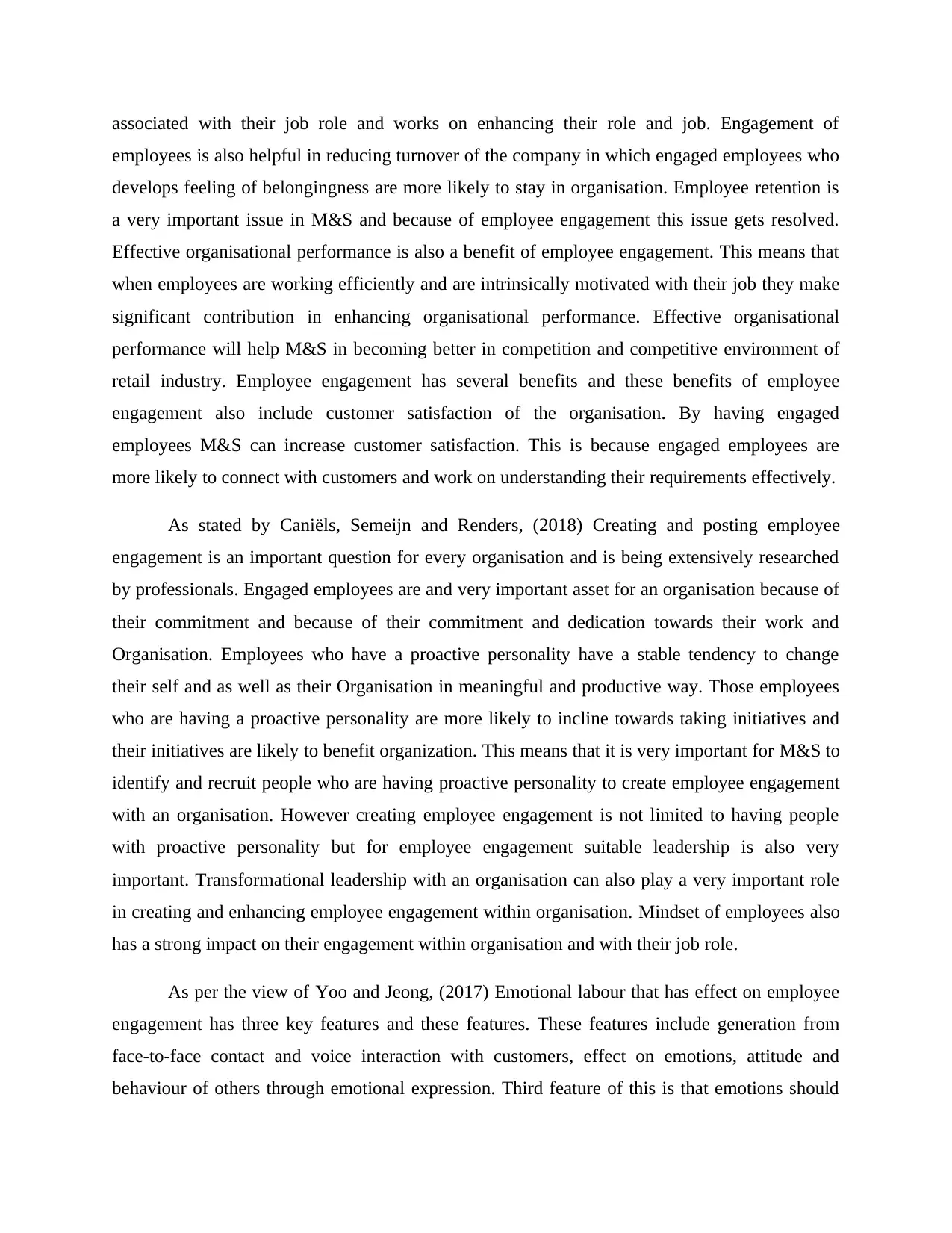
associated with their job role and works on enhancing their role and job. Engagement of
employees is also helpful in reducing turnover of the company in which engaged employees who
develops feeling of belongingness are more likely to stay in organisation. Employee retention is
a very important issue in M&S and because of employee engagement this issue gets resolved.
Effective organisational performance is also a benefit of employee engagement. This means that
when employees are working efficiently and are intrinsically motivated with their job they make
significant contribution in enhancing organisational performance. Effective organisational
performance will help M&S in becoming better in competition and competitive environment of
retail industry. Employee engagement has several benefits and these benefits of employee
engagement also include customer satisfaction of the organisation. By having engaged
employees M&S can increase customer satisfaction. This is because engaged employees are
more likely to connect with customers and work on understanding their requirements effectively.
As stated by Caniëls, Semeijn and Renders, (2018) Creating and posting employee
engagement is an important question for every organisation and is being extensively researched
by professionals. Engaged employees are and very important asset for an organisation because of
their commitment and because of their commitment and dedication towards their work and
Organisation. Employees who have a proactive personality have a stable tendency to change
their self and as well as their Organisation in meaningful and productive way. Those employees
who are having a proactive personality are more likely to incline towards taking initiatives and
their initiatives are likely to benefit organization. This means that it is very important for M&S to
identify and recruit people who are having proactive personality to create employee engagement
with an organisation. However creating employee engagement is not limited to having people
with proactive personality but for employee engagement suitable leadership is also very
important. Transformational leadership with an organisation can also play a very important role
in creating and enhancing employee engagement within organisation. Mindset of employees also
has a strong impact on their engagement within organisation and with their job role.
As per the view of Yoo and Jeong, (2017) Emotional labour that has effect on employee
engagement has three key features and these features. These features include generation from
face-to-face contact and voice interaction with customers, effect on emotions, attitude and
behaviour of others through emotional expression. Third feature of this is that emotions should
employees is also helpful in reducing turnover of the company in which engaged employees who
develops feeling of belongingness are more likely to stay in organisation. Employee retention is
a very important issue in M&S and because of employee engagement this issue gets resolved.
Effective organisational performance is also a benefit of employee engagement. This means that
when employees are working efficiently and are intrinsically motivated with their job they make
significant contribution in enhancing organisational performance. Effective organisational
performance will help M&S in becoming better in competition and competitive environment of
retail industry. Employee engagement has several benefits and these benefits of employee
engagement also include customer satisfaction of the organisation. By having engaged
employees M&S can increase customer satisfaction. This is because engaged employees are
more likely to connect with customers and work on understanding their requirements effectively.
As stated by Caniëls, Semeijn and Renders, (2018) Creating and posting employee
engagement is an important question for every organisation and is being extensively researched
by professionals. Engaged employees are and very important asset for an organisation because of
their commitment and because of their commitment and dedication towards their work and
Organisation. Employees who have a proactive personality have a stable tendency to change
their self and as well as their Organisation in meaningful and productive way. Those employees
who are having a proactive personality are more likely to incline towards taking initiatives and
their initiatives are likely to benefit organization. This means that it is very important for M&S to
identify and recruit people who are having proactive personality to create employee engagement
with an organisation. However creating employee engagement is not limited to having people
with proactive personality but for employee engagement suitable leadership is also very
important. Transformational leadership with an organisation can also play a very important role
in creating and enhancing employee engagement within organisation. Mindset of employees also
has a strong impact on their engagement within organisation and with their job role.
As per the view of Yoo and Jeong, (2017) Emotional labour that has effect on employee
engagement has three key features and these features. These features include generation from
face-to-face contact and voice interaction with customers, effect on emotions, attitude and
behaviour of others through emotional expression. Third feature of this is that emotions should
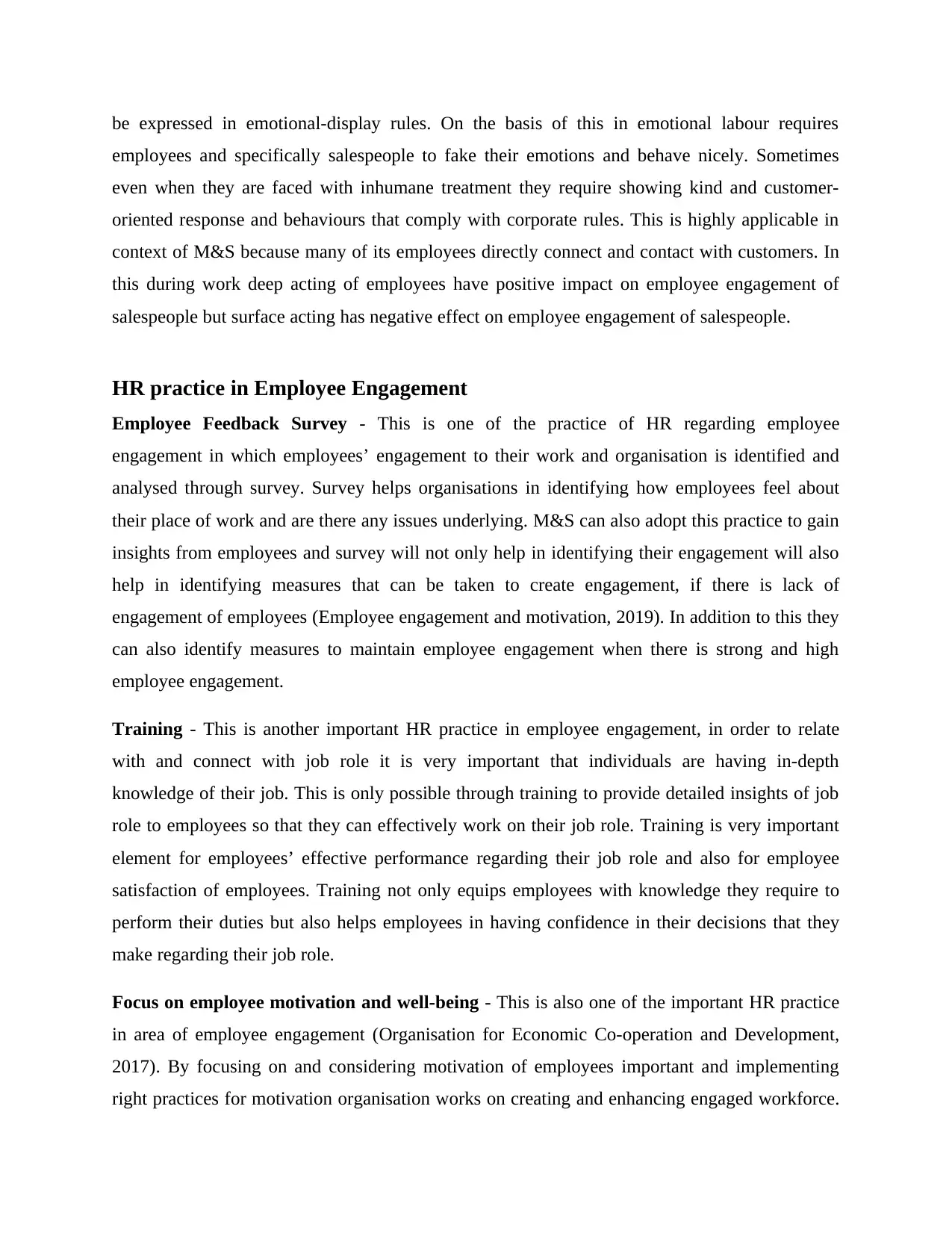
be expressed in emotional-display rules. On the basis of this in emotional labour requires
employees and specifically salespeople to fake their emotions and behave nicely. Sometimes
even when they are faced with inhumane treatment they require showing kind and customer-
oriented response and behaviours that comply with corporate rules. This is highly applicable in
context of M&S because many of its employees directly connect and contact with customers. In
this during work deep acting of employees have positive impact on employee engagement of
salespeople but surface acting has negative effect on employee engagement of salespeople.
HR practice in Employee Engagement
Employee Feedback Survey - This is one of the practice of HR regarding employee
engagement in which employees’ engagement to their work and organisation is identified and
analysed through survey. Survey helps organisations in identifying how employees feel about
their place of work and are there any issues underlying. M&S can also adopt this practice to gain
insights from employees and survey will not only help in identifying their engagement will also
help in identifying measures that can be taken to create engagement, if there is lack of
engagement of employees (Employee engagement and motivation, 2019). In addition to this they
can also identify measures to maintain employee engagement when there is strong and high
employee engagement.
Training - This is another important HR practice in employee engagement, in order to relate
with and connect with job role it is very important that individuals are having in-depth
knowledge of their job. This is only possible through training to provide detailed insights of job
role to employees so that they can effectively work on their job role. Training is very important
element for employees’ effective performance regarding their job role and also for employee
satisfaction of employees. Training not only equips employees with knowledge they require to
perform their duties but also helps employees in having confidence in their decisions that they
make regarding their job role.
Focus on employee motivation and well-being - This is also one of the important HR practice
in area of employee engagement (Organisation for Economic Co-operation and Development,
2017). By focusing on and considering motivation of employees important and implementing
right practices for motivation organisation works on creating and enhancing engaged workforce.
employees and specifically salespeople to fake their emotions and behave nicely. Sometimes
even when they are faced with inhumane treatment they require showing kind and customer-
oriented response and behaviours that comply with corporate rules. This is highly applicable in
context of M&S because many of its employees directly connect and contact with customers. In
this during work deep acting of employees have positive impact on employee engagement of
salespeople but surface acting has negative effect on employee engagement of salespeople.
HR practice in Employee Engagement
Employee Feedback Survey - This is one of the practice of HR regarding employee
engagement in which employees’ engagement to their work and organisation is identified and
analysed through survey. Survey helps organisations in identifying how employees feel about
their place of work and are there any issues underlying. M&S can also adopt this practice to gain
insights from employees and survey will not only help in identifying their engagement will also
help in identifying measures that can be taken to create engagement, if there is lack of
engagement of employees (Employee engagement and motivation, 2019). In addition to this they
can also identify measures to maintain employee engagement when there is strong and high
employee engagement.
Training - This is another important HR practice in employee engagement, in order to relate
with and connect with job role it is very important that individuals are having in-depth
knowledge of their job. This is only possible through training to provide detailed insights of job
role to employees so that they can effectively work on their job role. Training is very important
element for employees’ effective performance regarding their job role and also for employee
satisfaction of employees. Training not only equips employees with knowledge they require to
perform their duties but also helps employees in having confidence in their decisions that they
make regarding their job role.
Focus on employee motivation and well-being - This is also one of the important HR practice
in area of employee engagement (Organisation for Economic Co-operation and Development,
2017). By focusing on and considering motivation of employees important and implementing
right practices for motivation organisation works on creating and enhancing engaged workforce.
⊘ This is a preview!⊘
Do you want full access?
Subscribe today to unlock all pages.

Trusted by 1+ million students worldwide
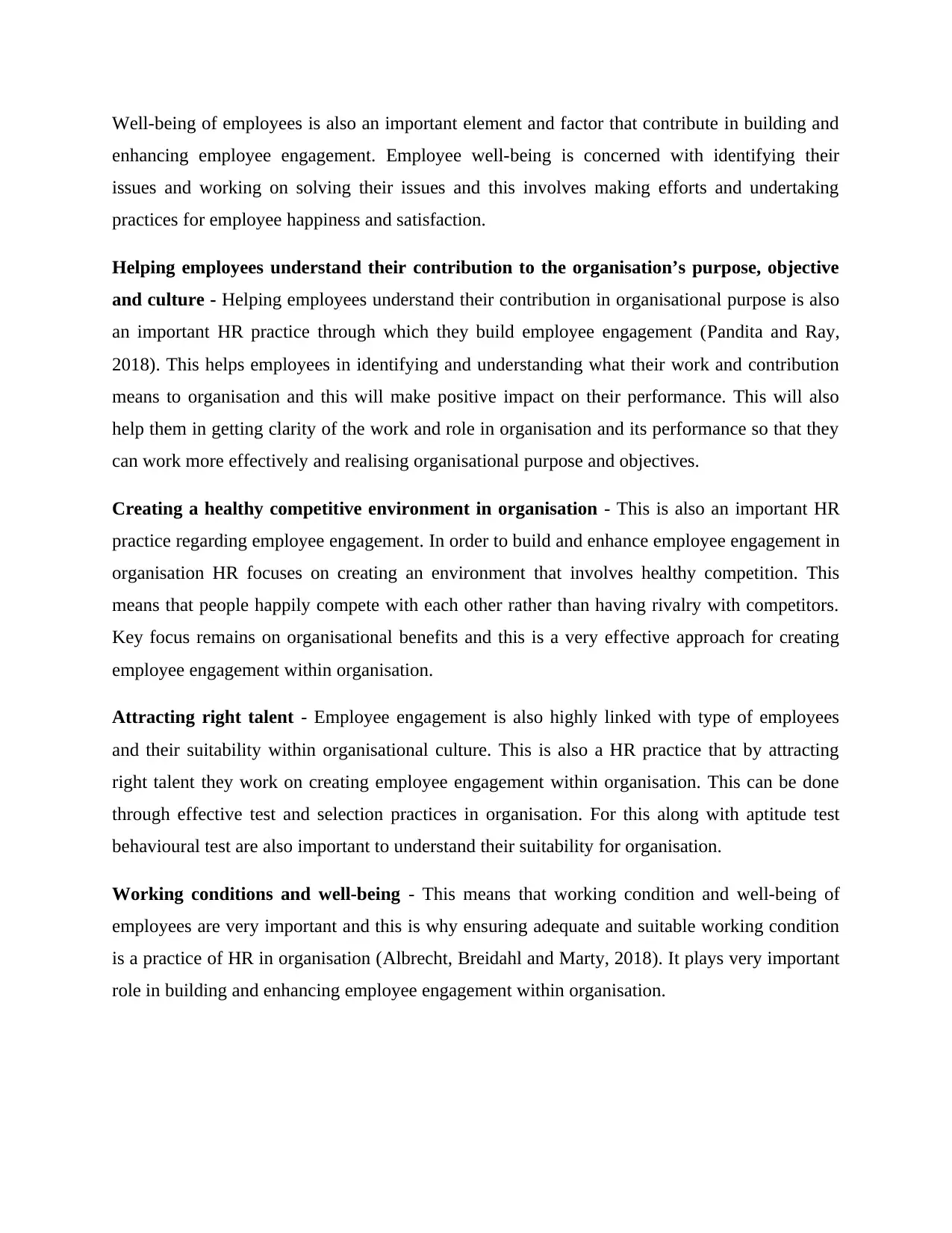
Well-being of employees is also an important element and factor that contribute in building and
enhancing employee engagement. Employee well-being is concerned with identifying their
issues and working on solving their issues and this involves making efforts and undertaking
practices for employee happiness and satisfaction.
Helping employees understand their contribution to the organisation’s purpose, objective
and culture - Helping employees understand their contribution in organisational purpose is also
an important HR practice through which they build employee engagement (Pandita and Ray,
2018). This helps employees in identifying and understanding what their work and contribution
means to organisation and this will make positive impact on their performance. This will also
help them in getting clarity of the work and role in organisation and its performance so that they
can work more effectively and realising organisational purpose and objectives.
Creating a healthy competitive environment in organisation - This is also an important HR
practice regarding employee engagement. In order to build and enhance employee engagement in
organisation HR focuses on creating an environment that involves healthy competition. This
means that people happily compete with each other rather than having rivalry with competitors.
Key focus remains on organisational benefits and this is a very effective approach for creating
employee engagement within organisation.
Attracting right talent - Employee engagement is also highly linked with type of employees
and their suitability within organisational culture. This is also a HR practice that by attracting
right talent they work on creating employee engagement within organisation. This can be done
through effective test and selection practices in organisation. For this along with aptitude test
behavioural test are also important to understand their suitability for organisation.
Working conditions and well-being - This means that working condition and well-being of
employees are very important and this is why ensuring adequate and suitable working condition
is a practice of HR in organisation (Albrecht, Breidahl and Marty, 2018). It plays very important
role in building and enhancing employee engagement within organisation.
enhancing employee engagement. Employee well-being is concerned with identifying their
issues and working on solving their issues and this involves making efforts and undertaking
practices for employee happiness and satisfaction.
Helping employees understand their contribution to the organisation’s purpose, objective
and culture - Helping employees understand their contribution in organisational purpose is also
an important HR practice through which they build employee engagement (Pandita and Ray,
2018). This helps employees in identifying and understanding what their work and contribution
means to organisation and this will make positive impact on their performance. This will also
help them in getting clarity of the work and role in organisation and its performance so that they
can work more effectively and realising organisational purpose and objectives.
Creating a healthy competitive environment in organisation - This is also an important HR
practice regarding employee engagement. In order to build and enhance employee engagement in
organisation HR focuses on creating an environment that involves healthy competition. This
means that people happily compete with each other rather than having rivalry with competitors.
Key focus remains on organisational benefits and this is a very effective approach for creating
employee engagement within organisation.
Attracting right talent - Employee engagement is also highly linked with type of employees
and their suitability within organisational culture. This is also a HR practice that by attracting
right talent they work on creating employee engagement within organisation. This can be done
through effective test and selection practices in organisation. For this along with aptitude test
behavioural test are also important to understand their suitability for organisation.
Working conditions and well-being - This means that working condition and well-being of
employees are very important and this is why ensuring adequate and suitable working condition
is a practice of HR in organisation (Albrecht, Breidahl and Marty, 2018). It plays very important
role in building and enhancing employee engagement within organisation.
Paraphrase This Document
Need a fresh take? Get an instant paraphrase of this document with our AI Paraphraser
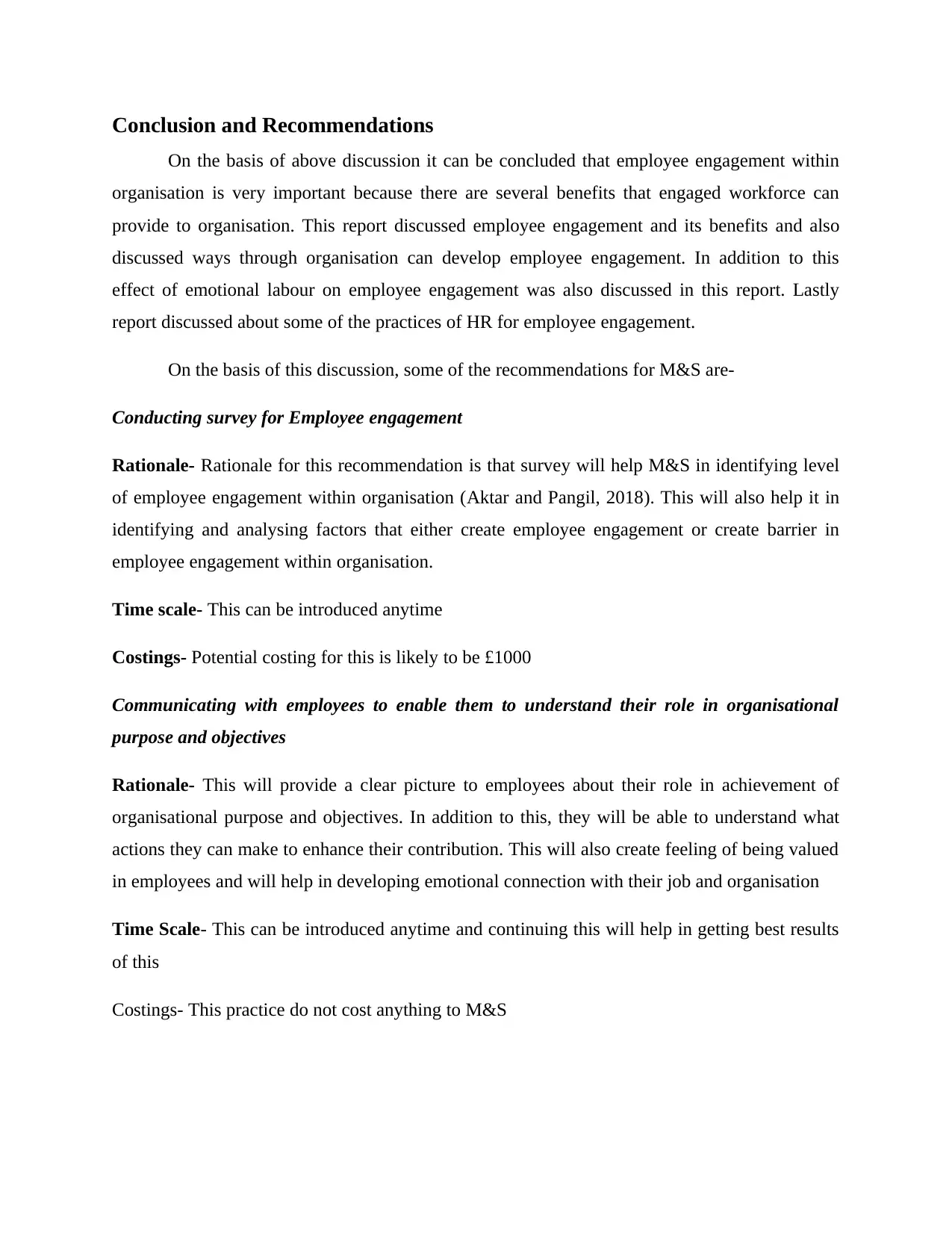
Conclusion and Recommendations
On the basis of above discussion it can be concluded that employee engagement within
organisation is very important because there are several benefits that engaged workforce can
provide to organisation. This report discussed employee engagement and its benefits and also
discussed ways through organisation can develop employee engagement. In addition to this
effect of emotional labour on employee engagement was also discussed in this report. Lastly
report discussed about some of the practices of HR for employee engagement.
On the basis of this discussion, some of the recommendations for M&S are-
Conducting survey for Employee engagement
Rationale- Rationale for this recommendation is that survey will help M&S in identifying level
of employee engagement within organisation (Aktar and Pangil, 2018). This will also help it in
identifying and analysing factors that either create employee engagement or create barrier in
employee engagement within organisation.
Time scale- This can be introduced anytime
Costings- Potential costing for this is likely to be £1000
Communicating with employees to enable them to understand their role in organisational
purpose and objectives
Rationale- This will provide a clear picture to employees about their role in achievement of
organisational purpose and objectives. In addition to this, they will be able to understand what
actions they can make to enhance their contribution. This will also create feeling of being valued
in employees and will help in developing emotional connection with their job and organisation
Time Scale- This can be introduced anytime and continuing this will help in getting best results
of this
Costings- This practice do not cost anything to M&S
On the basis of above discussion it can be concluded that employee engagement within
organisation is very important because there are several benefits that engaged workforce can
provide to organisation. This report discussed employee engagement and its benefits and also
discussed ways through organisation can develop employee engagement. In addition to this
effect of emotional labour on employee engagement was also discussed in this report. Lastly
report discussed about some of the practices of HR for employee engagement.
On the basis of this discussion, some of the recommendations for M&S are-
Conducting survey for Employee engagement
Rationale- Rationale for this recommendation is that survey will help M&S in identifying level
of employee engagement within organisation (Aktar and Pangil, 2018). This will also help it in
identifying and analysing factors that either create employee engagement or create barrier in
employee engagement within organisation.
Time scale- This can be introduced anytime
Costings- Potential costing for this is likely to be £1000
Communicating with employees to enable them to understand their role in organisational
purpose and objectives
Rationale- This will provide a clear picture to employees about their role in achievement of
organisational purpose and objectives. In addition to this, they will be able to understand what
actions they can make to enhance their contribution. This will also create feeling of being valued
in employees and will help in developing emotional connection with their job and organisation
Time Scale- This can be introduced anytime and continuing this will help in getting best results
of this
Costings- This practice do not cost anything to M&S
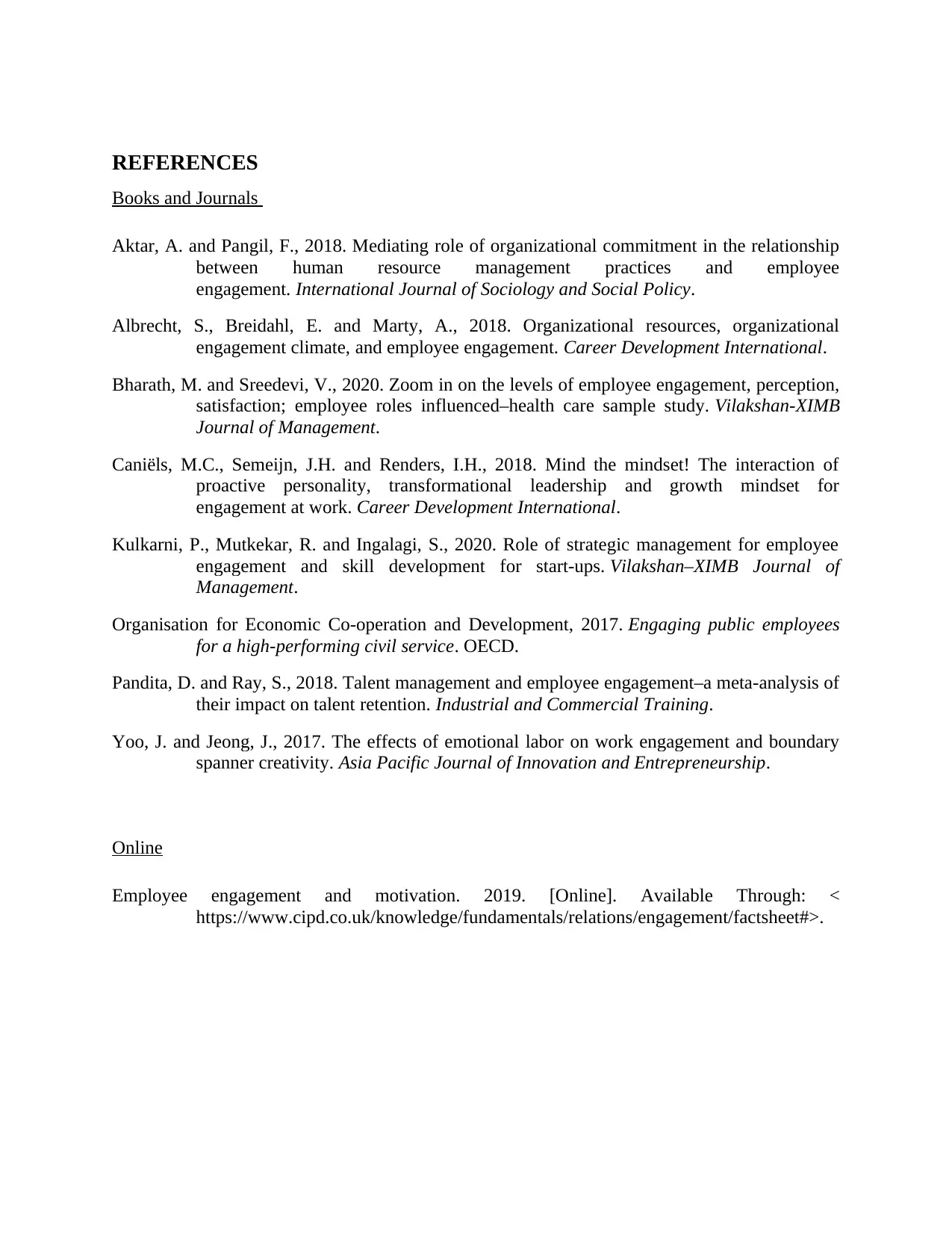
REFERENCES
Books and Journals
Aktar, A. and Pangil, F., 2018. Mediating role of organizational commitment in the relationship
between human resource management practices and employee
engagement. International Journal of Sociology and Social Policy.
Albrecht, S., Breidahl, E. and Marty, A., 2018. Organizational resources, organizational
engagement climate, and employee engagement. Career Development International.
Bharath, M. and Sreedevi, V., 2020. Zoom in on the levels of employee engagement, perception,
satisfaction; employee roles influenced–health care sample study. Vilakshan-XIMB
Journal of Management.
Caniëls, M.C., Semeijn, J.H. and Renders, I.H., 2018. Mind the mindset! The interaction of
proactive personality, transformational leadership and growth mindset for
engagement at work. Career Development International.
Kulkarni, P., Mutkekar, R. and Ingalagi, S., 2020. Role of strategic management for employee
engagement and skill development for start-ups. Vilakshan–XIMB Journal of
Management.
Organisation for Economic Co-operation and Development, 2017. Engaging public employees
for a high-performing civil service. OECD.
Pandita, D. and Ray, S., 2018. Talent management and employee engagement–a meta-analysis of
their impact on talent retention. Industrial and Commercial Training.
Yoo, J. and Jeong, J., 2017. The effects of emotional labor on work engagement and boundary
spanner creativity. Asia Pacific Journal of Innovation and Entrepreneurship.
Online
Employee engagement and motivation. 2019. [Online]. Available Through: <
https://www.cipd.co.uk/knowledge/fundamentals/relations/engagement/factsheet#>.
Books and Journals
Aktar, A. and Pangil, F., 2018. Mediating role of organizational commitment in the relationship
between human resource management practices and employee
engagement. International Journal of Sociology and Social Policy.
Albrecht, S., Breidahl, E. and Marty, A., 2018. Organizational resources, organizational
engagement climate, and employee engagement. Career Development International.
Bharath, M. and Sreedevi, V., 2020. Zoom in on the levels of employee engagement, perception,
satisfaction; employee roles influenced–health care sample study. Vilakshan-XIMB
Journal of Management.
Caniëls, M.C., Semeijn, J.H. and Renders, I.H., 2018. Mind the mindset! The interaction of
proactive personality, transformational leadership and growth mindset for
engagement at work. Career Development International.
Kulkarni, P., Mutkekar, R. and Ingalagi, S., 2020. Role of strategic management for employee
engagement and skill development for start-ups. Vilakshan–XIMB Journal of
Management.
Organisation for Economic Co-operation and Development, 2017. Engaging public employees
for a high-performing civil service. OECD.
Pandita, D. and Ray, S., 2018. Talent management and employee engagement–a meta-analysis of
their impact on talent retention. Industrial and Commercial Training.
Yoo, J. and Jeong, J., 2017. The effects of emotional labor on work engagement and boundary
spanner creativity. Asia Pacific Journal of Innovation and Entrepreneurship.
Online
Employee engagement and motivation. 2019. [Online]. Available Through: <
https://www.cipd.co.uk/knowledge/fundamentals/relations/engagement/factsheet#>.
⊘ This is a preview!⊘
Do you want full access?
Subscribe today to unlock all pages.

Trusted by 1+ million students worldwide
1 out of 9
Related Documents
Your All-in-One AI-Powered Toolkit for Academic Success.
+13062052269
info@desklib.com
Available 24*7 on WhatsApp / Email
![[object Object]](/_next/static/media/star-bottom.7253800d.svg)
Unlock your academic potential
Copyright © 2020–2025 A2Z Services. All Rights Reserved. Developed and managed by ZUCOL.




